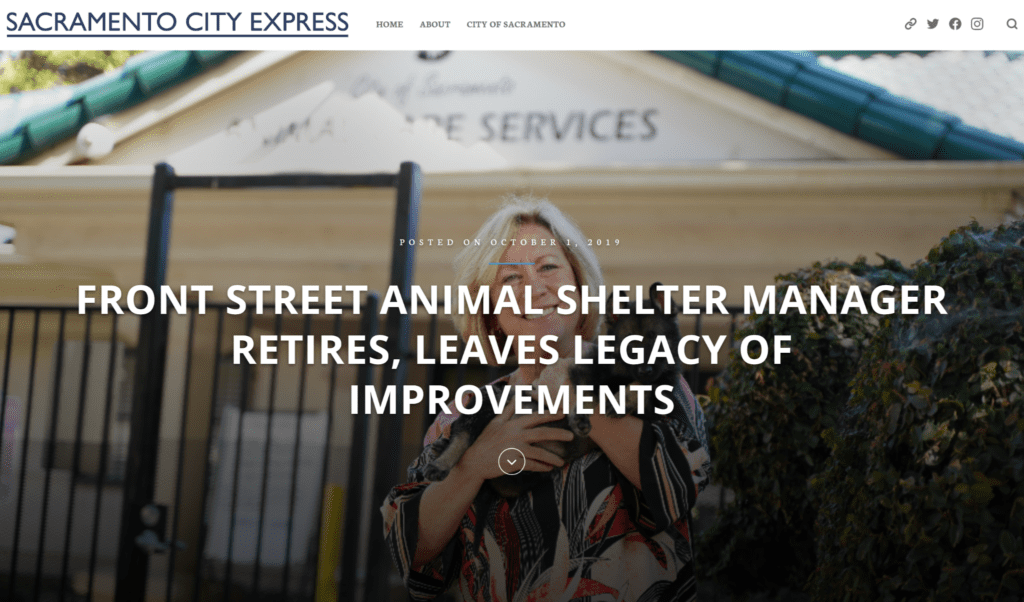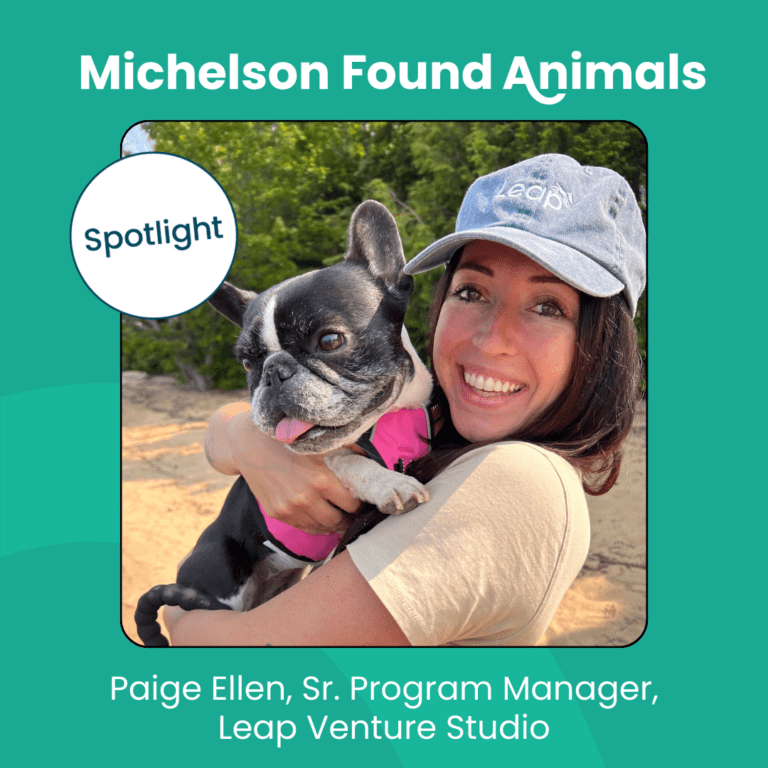Celebrating the Work of Gina Knepp: National Shelter Engagement Director of Michelson Found Animals Foundation
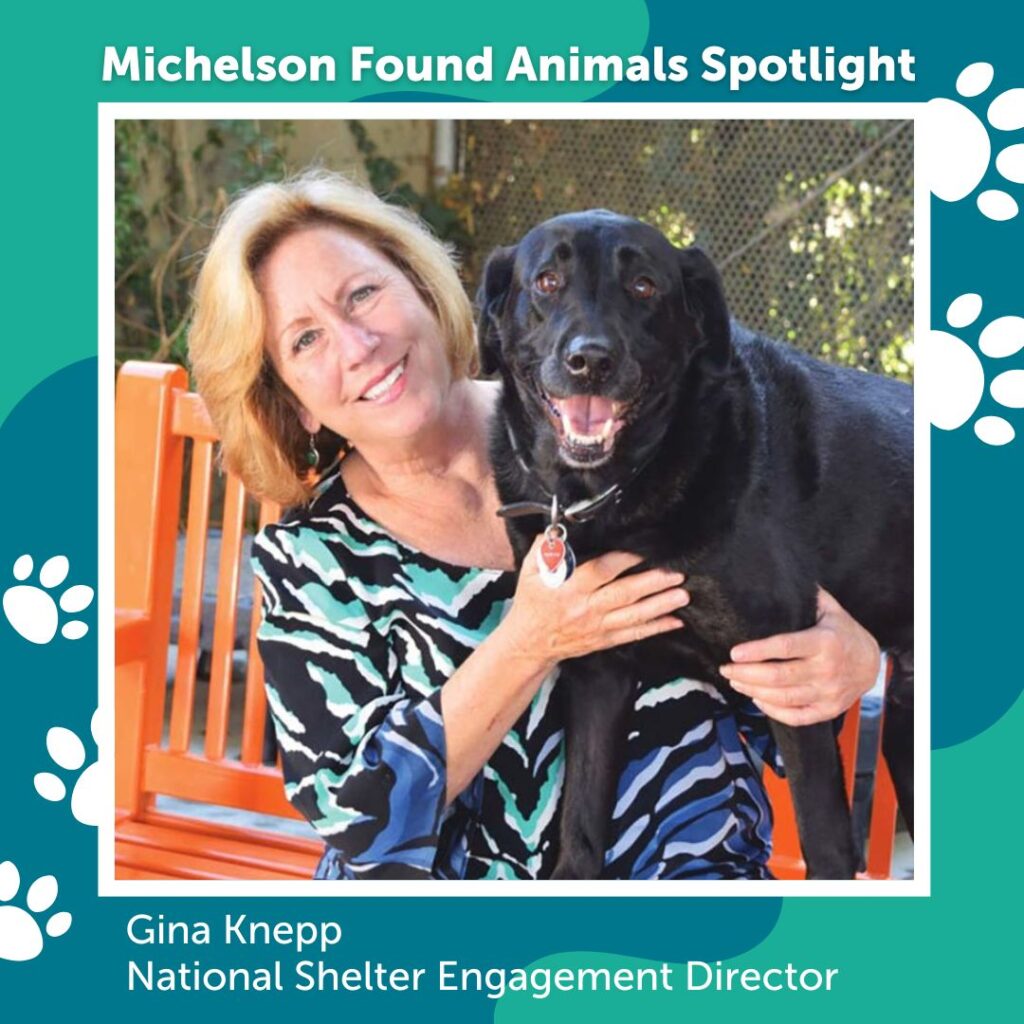
Gina Knepp was working for the city of Sacramento when her boss gave her an assignment: Go to the Sacramento animal shelter, and shut it down.
“I didn’t know a darn thing about animals,” said Gina. But it didn’t matter. She was an effective leader, and it turns out that was exactly what that Sacramento shelter needed. So, instead of shutting it down, Gina decided to save it, thus starting a long, public career with the simple goal of saving the lives of as many animals as possible.
Table of Contents
Michelson Found Animals Foundation
How to Prevent Your Pet from Getting Lost
Michelson Found Animals and Maddie’s Fund
How to Save an Animal Shelter
When Gina arrived at the Sacramento shelter, around 75% of found dogs and cats were being euthanized. Putting down the animals was cheaper, but it took an emotional toll. Gina noted an upsetting amount of compassion fatigue in the shelter industry from people who loved animals and wanted to help them but whose psyches had become burdened with the heavy realities of shelter work.
But Gina saw a world of possibilities. She changed the name of the shelter to Front Street, she came in with unbeatable hope for the organization, and she adopted the motto:
“Try anything once.”
“Whoever is in charge is responsible for the personality of the organization,” Gina pointed out. “When the leader has optimism and energy and is willing to work hard, those things rub off on people. [At Front Street,] we built excitement around saving animals’ lives.”
People in the organization would come to Gina with zany ideas, and she would try them all. Her goal? Get the word out about Front Street. Gina wanted the community to know about their work, even if that meant (literally) jumping out of an airplane. Front Street was constantly in the news for its events and fundraisers. As a result, the Sacramento community embraced the shelter. It became the people’s shelter– a place where, if someone’s pet ended up there, they knew the animal was in good hands.
“I really just drove the bus, and the people in the shelter did the heavy lifting,” Gina pointed out, giving credit to the hard work of her team.
But she certainly was great behind the wheel, and as a result of her policy changes, the people who worked and volunteered at Front Street began to have fun at work again. Gina found that the world is full of animal lovers who are willing to help; they just need to know where to direct that goodwill. Along with money that came in from donations and fundraising events, when word started to get out about Front Street’s work, the city was willing to invest more in them as well.
“When I left, we were taking in a million per year in donations. We built a medical building. We got a huge transport vehicle. Little things that well-sourced shelters take for granted,” Gina said.
When Gina first went to that Sacramento shelter, before it was Front Street, there were 31 positions for workers. When she left, there were 53.
Michelson Found Animals Foundation
After retiring from Front Street, Gina began her work with Michelson Found Animals Foundation.
In the aftermath of Hurricane Katrina, Dr. Gary Michelson was hurt to see the number of animals who had been separated from their families. As a result, he started the Michelson Found Animals Foundation with the goal of getting animals to where they should be: home. Part of Michelson Found Animals is a chip registry where you can upload your animal’s chip information, and anyone who finds your lost pet would be able to access it.
When Gina started her work with Michelson Found Animals, he asked herself a very important question: “How are we going to give back to the shelter community?”
To answer that question, Gina travels all over the country and, more recently, all over the world as well. In her day-to-day, she does a lot of teaching, a lot of looking for small businesses in the pet space to invest in, and she still, of course, manages a lot of community outreach.
“We want to double the Return to Home rate,” said Gina. “Maybe that’s a little aggressive, but there’s no way to go but up.”
Return to Home (RTH)
It was during her time at Front Street that Gina noticed a problem in the animal shelter industry.
Most “stray” dogs are not stray dogs at all; they’re someone’s lost pet. If you see a dog in the street that appears to be lost, that animal is likely not more than 1,000 feet from its home.
But many people don’t know this, so they pick up dogs in the street, drive them to a shelter that could be miles away, and often the shelter will also treat that animal like a stray, subsequently seeking to re-home the animal instead of trying to get it back to its original family.
“Almost all dogs in the street in the US are someone’s animal,” Gina said. “We don’t have street dogs in this country. It’s either going on a stroll and knows exactly where it is, or it belongs to someone, and it’s lost.”
When Gina realized how many “stray” animals that end up at the shelter are just someone’s lost pet, it changed the way that she ran the organization. She has now become a well-known national advocate for RTH or “Return to Home” policies as the National Shelter Engagement Director for the Michelson Found Animals Foundation.
And Gina has some advice for people in the community and those who work in shelters on maximizing the number of pets returned to their families.
What to do if you Find a Lost Dog
“When you see a lost dog, your first thought shouldn’t be driving it to the shelter or calling animal control,” Gina advised. “We encourage people just to walk the neighborhood with that animal.” Gina pointed out that if you drive a lost dog to an animal shelter, the chances of reuniting that dog with its owners go down significantly. Ask yourself, if you lost your child in the grocery store and someone found them, would you want that person to drive your child 15 minutes to the Lost Kid Center, or would you want them to try to find you in the grocery store first?
If you find a lost pet, someone nearby will likely know whose dog that is, so try the following steps if it’s safe to do so:
- Knock on doors and ask people if it is their dog or if they know where the dog lives.
- Talk to the UPS drivers or mailmen, who often know where dogs live.
- Immediately file a report with Petco Love Lost, a resource to reunite lost animals with their families using facial recognition software.
- If the animal has a collar or tag, don’t just try calling the number on their collar, but also texting it or even Googling it if you aren’t getting responses. Often, a simple Google search of the number will produce an address.
- Contact your local shelter, and file a Found Report.
- See if someone has filed a Lost Pet Report on Pawboost or PetFBI.org.
- Use resources like Next Door, Facebook, or Craigslist to spread the word about the found dog.
And if you Find a Lost Cat?
“Most of the time, if you leave a cat alone, it will go home,” Gina said. Many cats are outdoor cats, and some even have multiple families. But if you are concerned about the well-being of the cat, then you can also try the steps above that work for reuniting a dog with its family.
How to Prevent Your Pet from Getting Lost
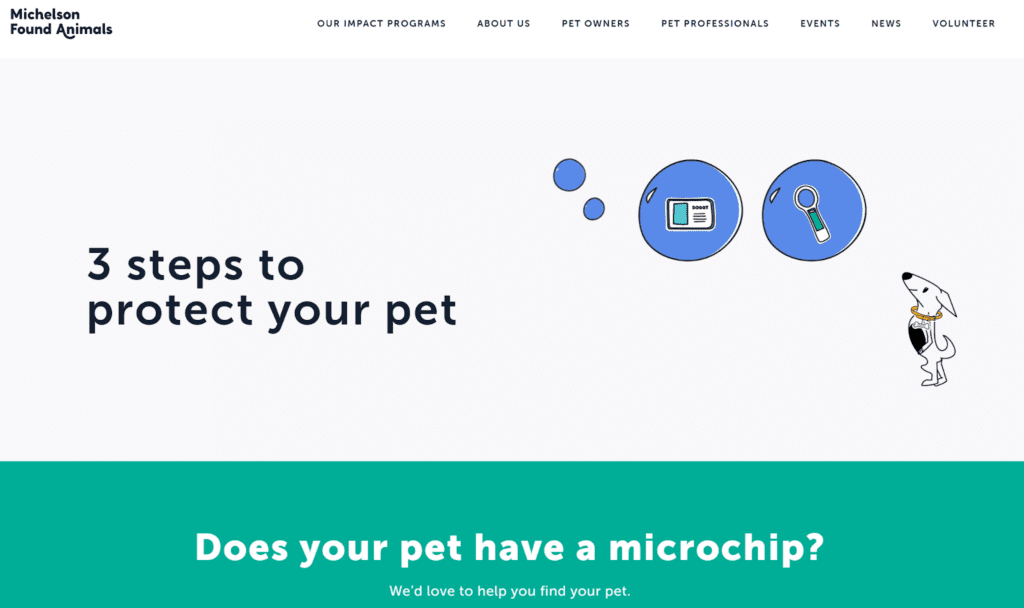
If you are a pet owner, ask yourself, is my pet microchipped? And is my microchip registered with up-to-date information?
“The microchip is like your car’s VIN, and an external tag [on the collar] is like the license plate. If you don’t register your car, and someone steals it, there’s no way to get it back,” said Gina.
For more information about updating your microchip and registering your pet, please go to this page, where you can find detailed steps for getting your microchip, registering it, and ensuring it’s up-to-date.
Another tip from Gina: save your pet’s microchip number in your phone as a contact under your pet’s name. Also, add the phone number for the microchip company. Paperwork is easy to lose, but you will often have your phone’s contacts readily available.
And if you do ever lose your dog and driving around looking for them doesn’t work, try out Petco Love Lost, Paw Boost, Craigslist, Facebook, and Nextdoor.
But shelters have microchip scanners, so if your dog is microchipped and that chip is registered with up-to-date information, then if your dog ends up in the shelter, then they should contact you using the information on the chip.
Note that if you’ve recently adopted your dog, it’s quite common for that dog to get lost in its first three days in a new home as it becomes accustomed to its surroundings. So make sure your dog has a tag and a registered microchip as soon as you bring it home, and pay careful attention to your animal in those first few days.
How Shelters Can do More for RTH
Returning animals to their families is not only the right thing to do. It is also cheaper than re-housing animals, better for shelter employees, and, of course, better for the animal and their families.
Benefits of Prioritizing RTH over Re-Housing Animals:
- Returning the lost animal to its owner is significantly less expensive than housing and feeding the animal until it is adopted.
- Every animal that is returned frees up a kennel.
- The lost animal is probably confused and afraid and wants to go home. It’s better for the animal to go back to the family and home that are familiar to them.
- Almost all lost pets have a family out there looking for them, worried about them, and desperate to see them again.
- Lost pet reunification stories are incredibly powerful. Sharing stories of lost pets reunited with their families on your shelter’s social media brings in more community support and positive attention.
- As mentioned briefly above, euthanasia takes an emotional toll on shelter workers. Reunification, on the other hand, reminds people why they chose to work with animals in the first place. As Gina put it, “When animals go home, morale goes up.”
It’s important to think about pet owners as well as their pets. Often, we treat lost pets in the same way we would a lost belonging, but with animals, there is much more of an emotional connection. “We focus so much on the animals,” Gina said, “but there’s a human being at the other end of the leash. We care about the person, and that’s why we really want what’s best for them.”
With so many notable benefits of RTH, what can shelters do to make sure more animals are reunited with their owners?
- When animals are adopted, make sure they leave with a registered microchip and wearing a tag, and explain to owners how they can update their microchip information if they ever move or change phone numbers.
- Encourage your animal control officers to spend some time knocking on doors and searching around the neighborhood before bringing the animal to the shelter. This simple act builds trust with the community.
- Scan all animals for a microchip, and, even better, offer microchip scanners to your control officers so that they can scan any animal they find.
- If an animal comes in with a collar and phone number, and the voicemail box hasn’t been set up, or they don’t answer, don’t stop there. Text the number; text messages are read over 90% of the time. Google the number to determine if it leads to an address.
- Post all pets that come into the shelter on social media and your shelter website immediately. Gina advised, “Every animal that shows up should be on the website. And the website needs to be friendly and easy to navigate.”
- Post stories and videos on your social media of pet reunification. Videos of tearful families being reunited with their pets will cause more people to hear about the shelter and more people to learn about RTH!
- Dedicate a position just to reuniting lost pets. Gina told me, “In Greensville, South Carolina, they hired someone who is in charge of lost pet reunification. They can show monetarily that that person’s salary is less than they would have spent on rehousing the animals that were instead returned.”
- Eliminate Return to Home fees, or waive fees on certain days. For example, some shelters waive their RTH fees around the 4th of July (a date when many pets run away from the fear of the noises from the fireworks), and they often see surges in people coming to pick up their lost pets. This surge in RTH tells us that there are people who want to get their pets back and know where they are but can’t afford the fees. Offer some days when they can be reunited with their beloved pet for free. In a perfect world, redemption fees should be completely eliminated.
- Don’t post images of “naked” animals. All the animals in your marketing images should have collars and tags to normalize the wearing of ID and to encourage people to always have some form of identification on their dog.
- Check out this comprehensive, self-paced course on animal reunification created by Gina and Maddie’s Fund.
Gina put it this way:
Shelters need to stop waiting for people to come and find us. We need to find people. Maybe the phone number is no good, but look them up on social media. It’s actually very easy to find people. Shelters need to do everything within their power to make it easier for animals to be reunited. The onus should be on us.
Learn more about MFA’s Return to Home program at foundanimals.org/return-to-home.
Michelson Found Animals and Maddie’s Fund
Michelson Found Animals partners with Maddie’s Fund to create grant opportunities for shelters that are willing to commit to RTH. For example, they create 30-day challenges and encourage shelters all over the country to apply. When reviewing the candidates for the grants, they ask questions like:
- Are your officers trying to get an animal home before bringing it to the shelter?
- Are you marketing the animals to the community via social media and an online presence?
- Does your organization frequently market the importance of pet identification, and do you make it affordably available to your community?
- What can we do to improve lost pet reunification?
A RTH Success Story
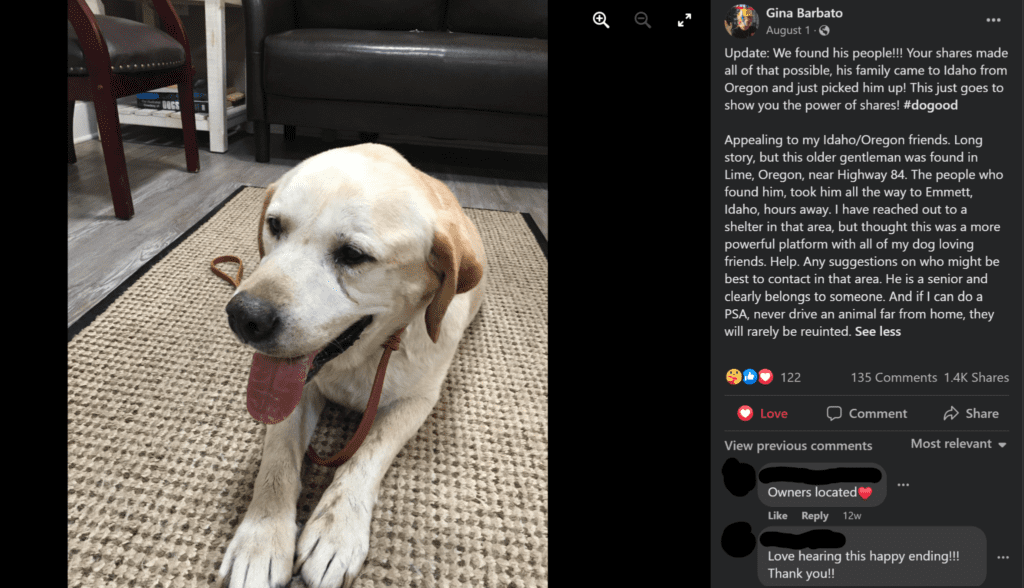
Gina manages the Facebook page for a small shelter in Idaho, and she still volunteers there while she also works for Michelson Found Animals. Recently, a family from Idaho went on vacation to Oregon and stayed in a campground. In the campground, they found a stray dog.
But it wasn’t a stray dog. A different family from Oregon had been displaced, and they were living in the campground with their long-time, elderly family dog.
But the well-meaning Idaho family who had found the dog put it in their car and drove that Oregonian dog to a shelter… in Idaho.
When Gina got word of the dog in the Idaho shelter and found out that the dog was found in Oregon, she was discouraged. She knew the chances of getting the dog home were slim from so far away. Regardless, she made a post on her personal Facebook page explaining the situation and asked people to help her.
And people responded in droves. The post was shared nearly 1,500 times. Less than 48 hours later, the right person saw it because of a Pawboost post, and the family heard about their dog. They drove to Idaho and picked up their adored family pup to bring him back home. It goes to show you that anyone can help create happy endings.
“Animal shelters are going through a renaissance.” –Gina Knepp
We are witnessing a new era of animal shelters, and Gina is one of the leaders at the forefront. Re-homing animals isn’t cutting it, and we’re ready to start sending animals to their true homes where they should be. Gina is creating a widespread impact on the animal shelter industry and leaving a legacy of animals who were once lost and are now safe with their loved ones. So, from Michelson Found Animals and everyone associated, and from all the animals and owners who are now together due to Gina’s actions, we’d like to send a heartfelt “Thank you, Gina, for everything you do!”
